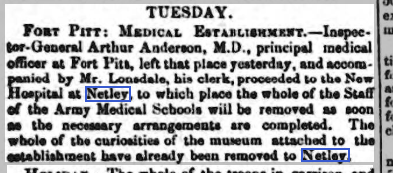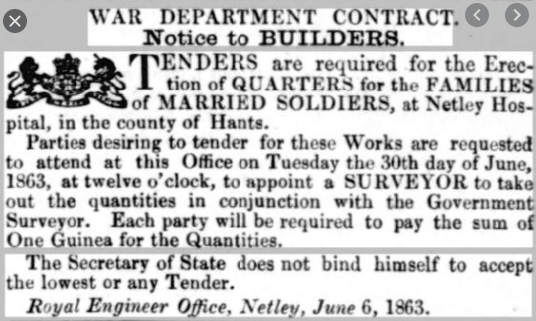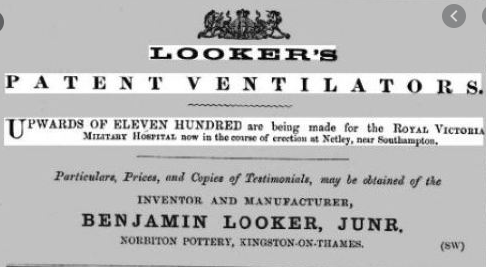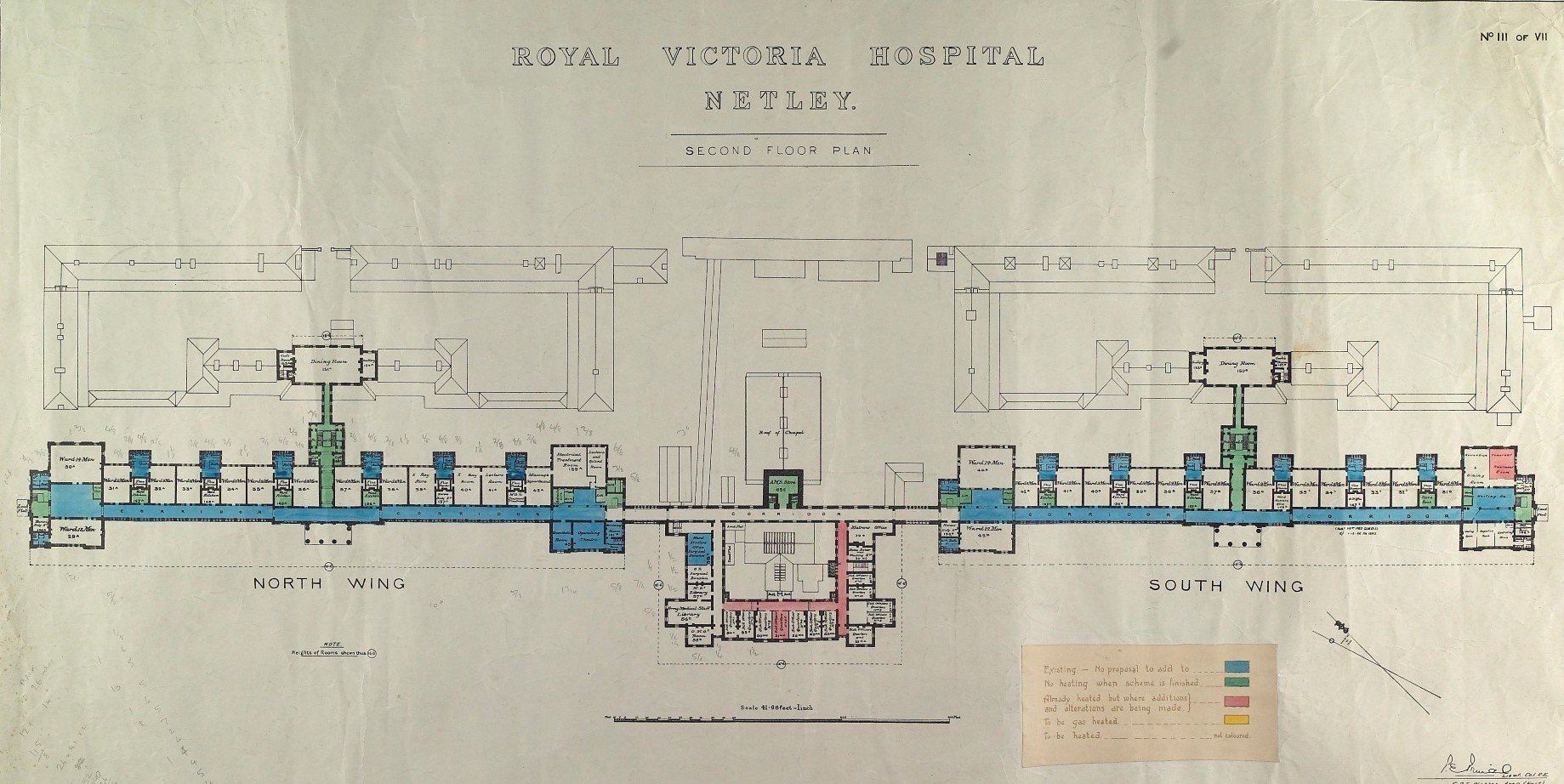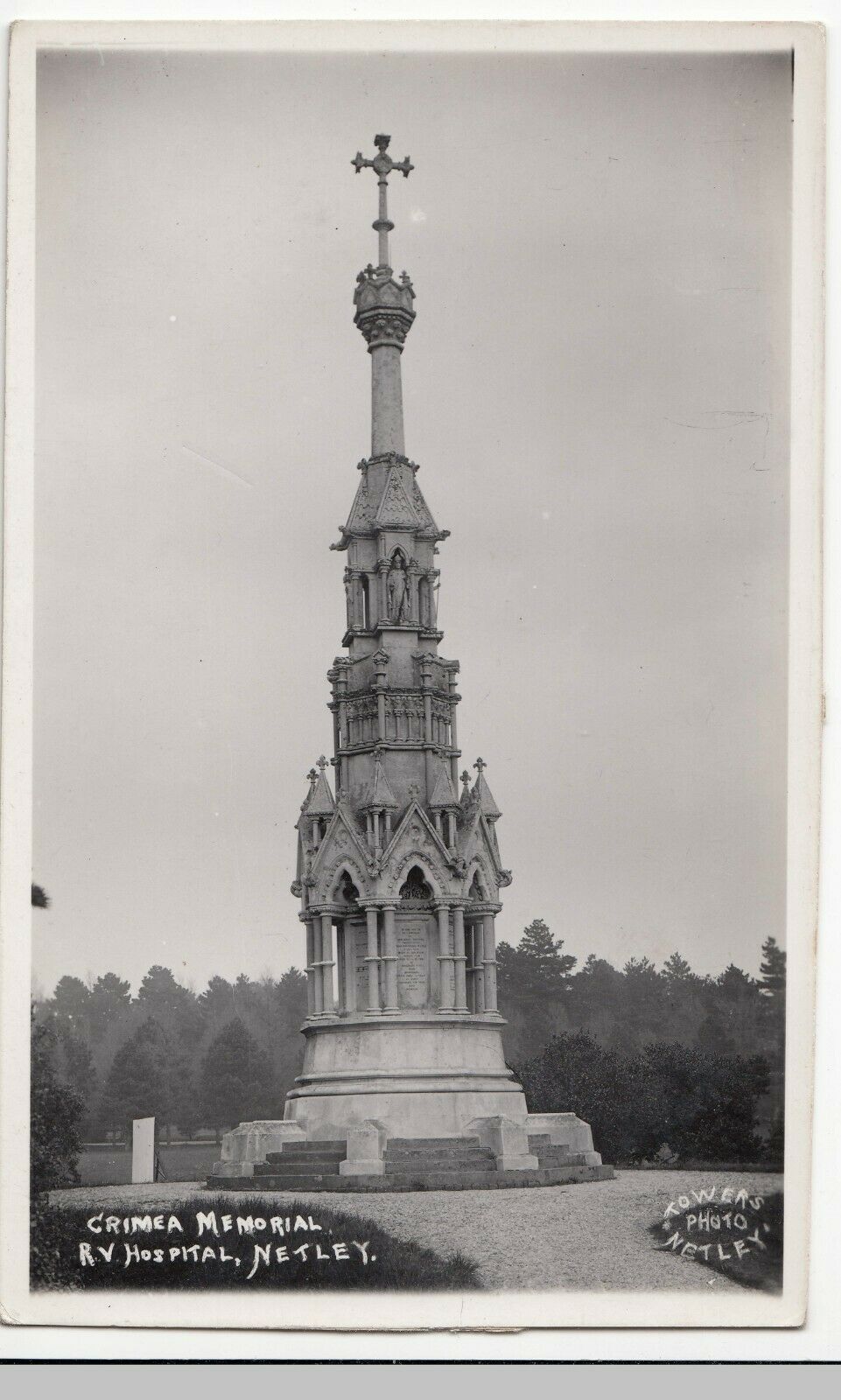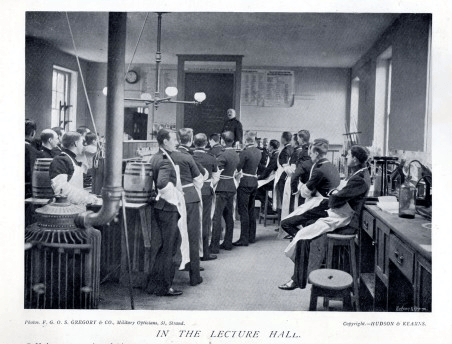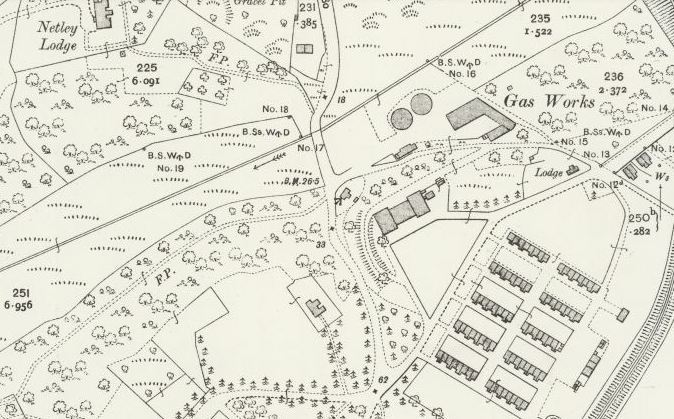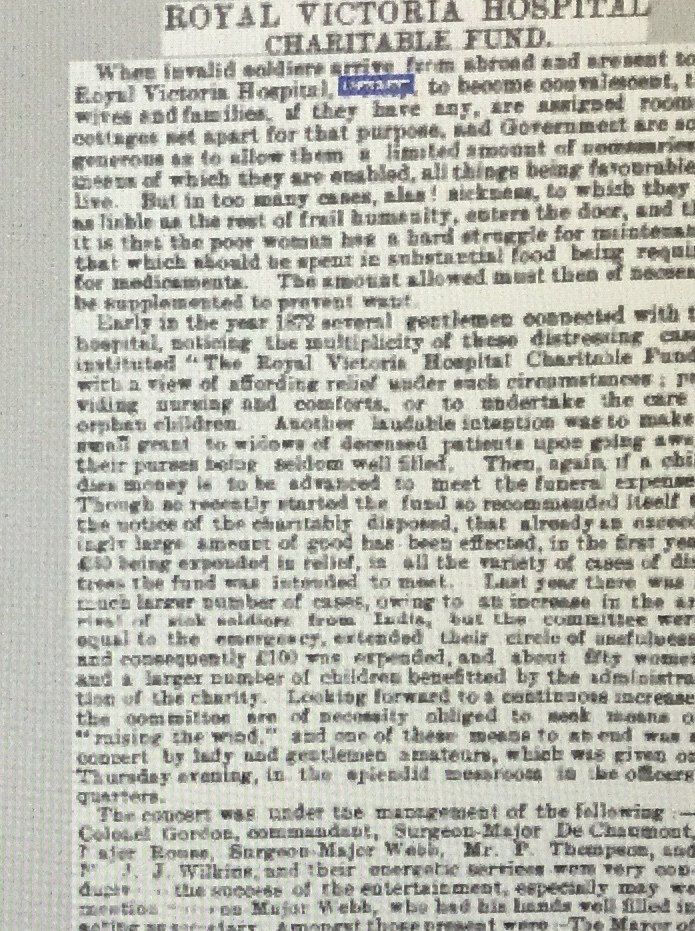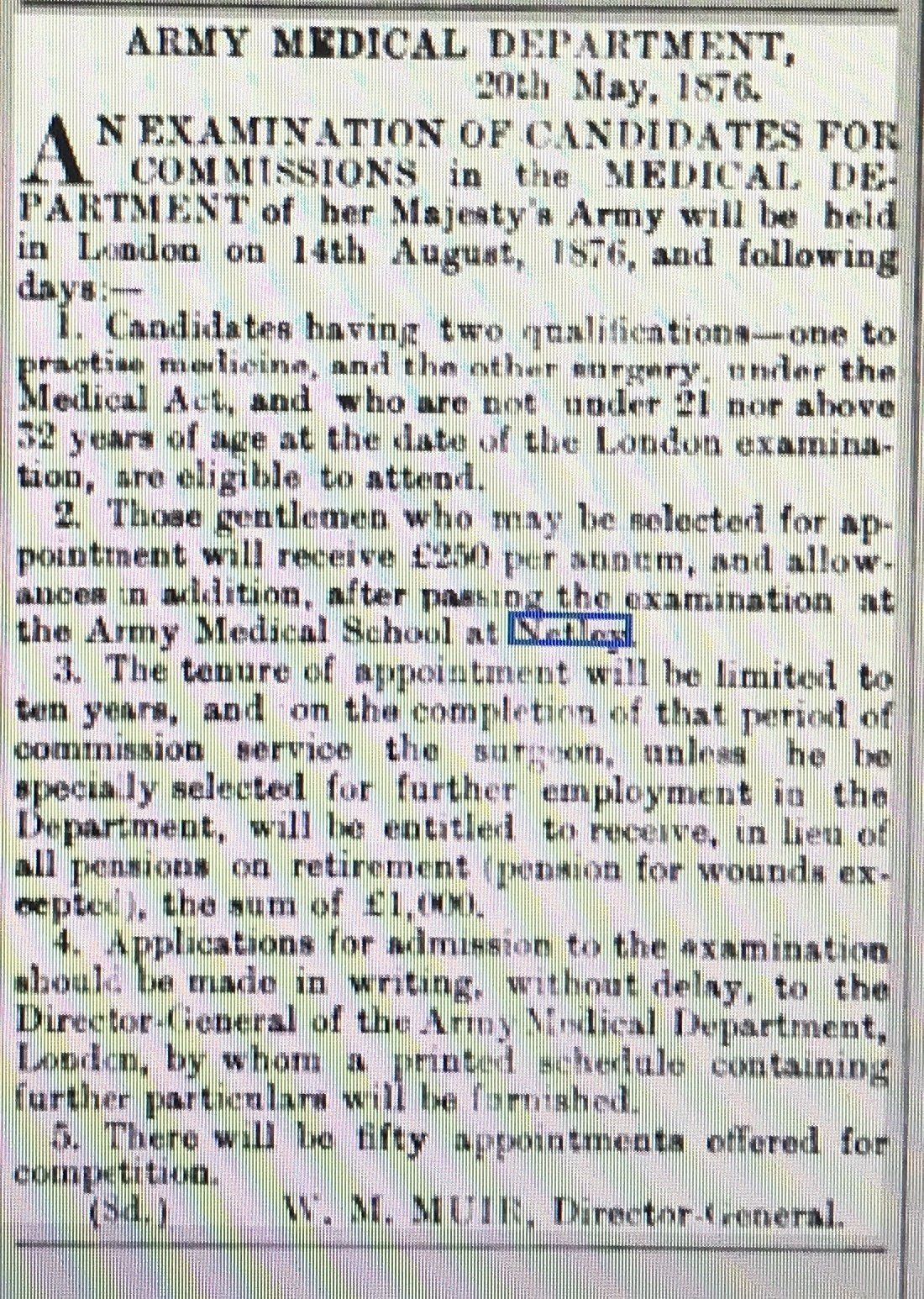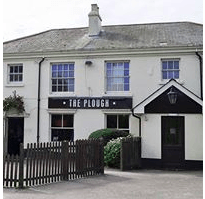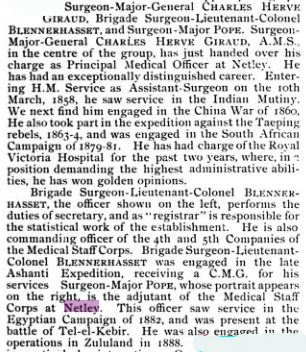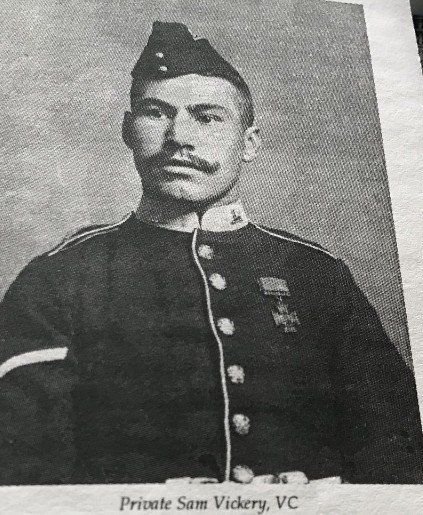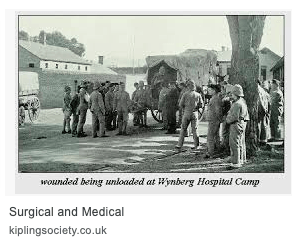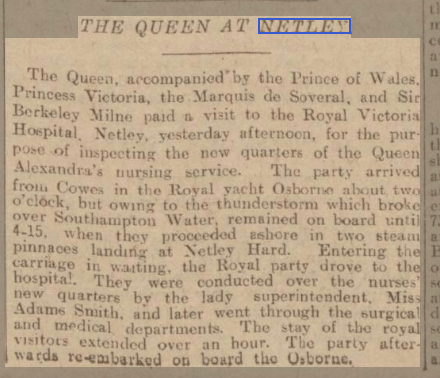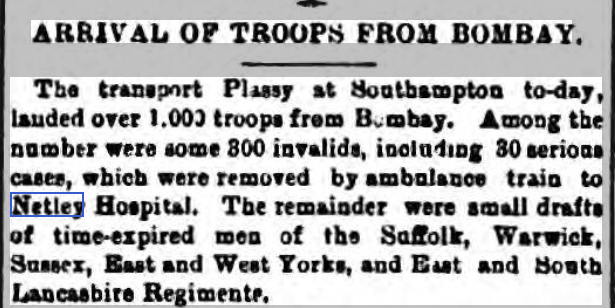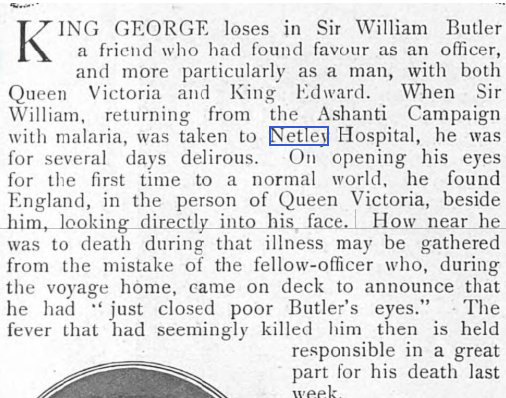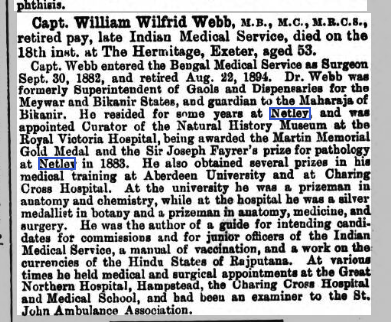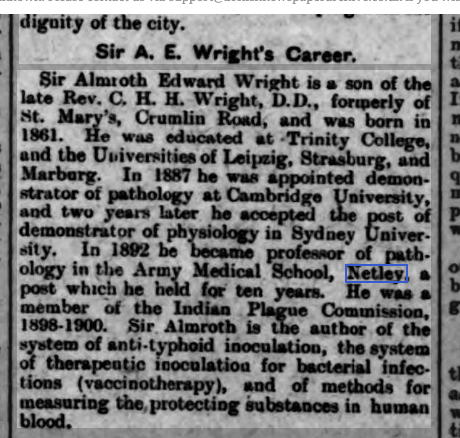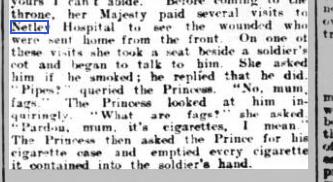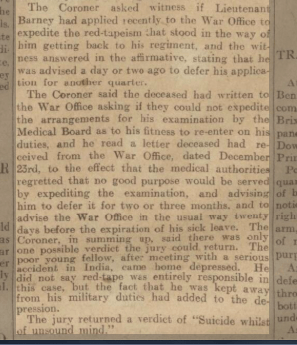NETLEY ABBEY MATTERS!
CHAPTER 1 - NETLEY MILITARY HOSPITAL 1856 - 1913
The Rev E H Pillifant, CF, wrote a history of the
"Royal Victoria Hospital at Netley - and the Chapel (1856 - 1934)"
It gives a wonderful description of the Hospital and outbuildings, its grounds and surrounding areas, paying tribute to its Scientists, Medical and Nursing Staff.
His second paragraph reads -
"In the year of grace 1856, James Young Simpson bestowed upon suffering humanity the priceless gift of chloroform; Charles Darwin sent his manuscript of the "Descent of Man" to Sir Joseph D Hooker; Louis Pasteur solved the problem of fermentation and putrefaction and was paving the way for his prophylactic treatment of hydrophobia and Joseph Lister was working on the continent anticipating his discovery of chemical antiseptic. Simultaneously with this range of new knowledge and its revolutionary teaching, the Crimean War was being waged and closely associated with both is the true story of the name which during the Great War travelled world-wide - 'Netley'."
[The full document is available on request]
To read more about the laying of the foundation stone of the military hospital, why not visit Netley Military Cemetery website - just remember to return here!
... then it was all systems go!
"It is now definitely stated that the principal officers of the Staff at Fort Pitt Hospital, Chatham together with the professors and heads of departments connected with the Army Medical School at that establishment, will leave the garrison and enter on their duties at Netley Hospital during the first week in the ensuing month, after which the entire Invalid Depot at St Mary's Barracks will also move to the same establishment.
As soon as the new arrangements are complete, Chatham will cease to be the station to which troops will be forwarded from all parts of the world for the purpose of being discharged.
Under the new system, the vessels arriving from abroad with troops will lie at Southampton Water, near Netley, where the time-expired men and invalids will be landed, when those not requiring medical or surgical treatment will be at once sent inland to their Depots or forwarded to their homes, while the sick and wounded only will be detained in the hospital, the plan of keeping up what is termed an Invalid Depot, as at Chatham, being discontinued.
The officers of the Staff already named as selected for the new hospital are -
Colonel Richard Wilbraham CB, Governor;
Major John Mackenzie Kennedy, Paymaster;
Captain William Hawtree, Captain of Orderlies"
[Naval + Military Gazette and Weekly Chronicle of the United Services, 21/02/1863]
Sir Thomas Longmore, Honorary Surgeon to the Queen
Surgeon-General, late of 19th Foot, Army Medical Department at Netley Hospital from 1863 to 1878
He was born on 10/10/1816 and entered the Army Medical Department on 03/02/1843 when he was the Assistant Surgeon to the 19th Foot. He was a colleague of Florence Nightingale.
In April 1863, he became the first Professor of Military Surgery at the Army Medical School at Netley.
He was a leading authority in gunshot wounds.
He was knighted in 1886.
He died suddenly on 30/09/1895 in Swanage, Kent,
aged 79.
web.archive.org/Friends of Green Howards; Sheffield Evening Telegraph 01/10/1895
Gunner John Counelaw
Service No 10354
Royal Artillery
He was born in Ireland.
He arrived at Netley from India on 18/04/1863, having served 4 years and 6 months.
He died at Netley on 30/11/1863. Cause of death was "morbid balcord ascites"
[abnormal build up of fluid in the abdomen]
Wellcome Library Postmortems courtesy of Julie Green
Private William Grinstead
Service No 621
2nd Battalion 17th Regiment of Foot
He was born in Somerset.
He was last admitted to Netley on 02/10/1863 suffering from Pulmonary Phisisis, contracted
whilst serving overseas.
He died at Netley on 13/12/1863, aged 24 after serving 5 years 1 month.
A Post-mortem examination was carried out on 17/12/1863.
Wellcome Post-mortem Reports via Julie Green
Gunner George Sadler
Service No 35
Royal Artillery
He was born in Staffordshire.
He was admitted to Netley Hospital on 31/10/1863 having suffered for 401 days from Neuralgia contracted
whilst in Montreal. He had served for 7 years + 10 months.
He died at Netley on 20/12/1863.
The post-mortem took place on 21/12/1863.
Wellcome Library Postmortems courtesy of Julie Green
Private Joseph Bell
Service No 139
2nd Battalion of 23rd Corps
He was born in Dumfries, Scotland.
He was admitted to Netley Hospital on 08/11/1863 suffering for 16 months with Chronic Pleuritis contracted whilst serving in Malta. He had served 5 years and 9 months.
He died at Netley on 19/05/1864, age 29.
Wellcome Library Postmortems courtesy of Julie Green
The Rev J A Crozier, Chaplain to the Forces, Army Chaplains Department.
He had one son born at the Hospital on 07/12/1863 and a second son on 22/09/1867.
Sadly his first son died on 25/09/1868, at 4 years old, after falling out of a window.
Dublin Evening Mail 09/12/1863; Pall Mall Gazette 24/09/1867; Oxford Journal 03/10/1868
Captain + Brevet Major Thomas Andrew Rawlins
Staff Captain and Assistant Commandant
Army Medical Corps
At Netley between 1863 and 1873
Promoted to Lt-Colonel in January 1870, retired on full pay 13/04/1872 with the honorary
rank of Colonel.
His eldest daughter, Kate Eliza Emily died of typhoid fever at the Hospital on 10/08/1866, aged 16.
In 1878, he was living at Gun House, Hamble.
Memorial to the Crimean Medical Officers at Netley Hospital
It was decided that the Army Medical Department wanted a monument to their comrades who died in the Crimea and Netley was chosen as the site, being the main military hospital in the country.
"On 1 August 1864, his Royal Highness, the Prince of Wales laid the foundation stone of a
memorial cross to those medical officers of the army who lost their lives during the war in the Crimea.
The military officers who fell in that campaign are honoured by monuments erected in those localities with which they were in their lifetime associated by education or by residence and in London, the Guards' Memorial and the Monument to the Westminster Scholars mark, in conspicuous positions, the loss which the country sustained in the Russian War.
The Army Medical Department. whose exertions were never more called for, and whose aid was never more serviceable than during the early disasters of that struggle, is now to have a record of its heroic members whose lives were sacrificed in ministering to the ease of others."
"The raised mound on which the cross is to be erected was surrounded by a species of evergreen
pavilion, of scaffold poles twined with laurels and flowers. In the centre was a pole the height of the intended cross, on the top of which the crest of the Prince, in gilt, was displayed."
"On reaching the foundation stone, the guard of honour again presented arms and their band played the National Anthem. Dr J B Gibson, the chairman of the Memorial Committee, then read the address to the Prince of Wales."
The following names were inscribed on the Monument -
Deputy Inspector General
T Spence MD
A McGrigor MD
Staff Surgeons First Class:
J Mitchell MD Chilley Pine G K Pitcairn MD N O’Connor MD J Marshall
Surgeons
F C Huthwaite, Grenadier Guards D Anderson MD, Staff
E LeBlanc, 9th Regiment P Mackey MD, Staff
W Simpson MD, 17th Regiment J Newton, Staff
W A Anderson, 41st Regiment J A Wishart MD, Staff
C Macartney MB, 77th Regiment M A Jane, Staff
F Smith, 95th Regiment C B Bassano, Staff
W Browne, 95th Regiment
Assistant Surgeons
M C Ancell, 11th Hussars J J Norris, 55th Regiment
J P Langham, 7th Regiment J F O’Leary, 68th Regiment
E S Wason, 13th Regiment J Grabham, 71st Regiment
W Renwick, 14th Regiment J H Gilborne, 71st Regiment
E A Jenkin, 23rd Regiment F Y Shegog MD, 88th Regiment
J Lamont MD, 41st Regiment J A Shorrock, Rifle Brigade
J Thomson MD, 44th Regiment A R Reid MD, Staff
H Beckwith, 49th Regiment E P Boyle, Staff
P G Martel, 50th Regiment F A Macartney, Staff
Acting Assistant Surgeons
H Ludlow T O Mitchell
A Struthers MD J Mayne
R T Simons H W Wood
J H White J Longmore
F Graham
Principal Apothecary
G H Reade
Dispensers of Medicines
J M Beveridge J H Whitwell
Hospital Dressers
H Harrison T Fell
Civil Surgeons
R J McKenzie MD, FRCS Ed E J Complin MRCS Eng
Civil Dispenser
J H Edmonds
Not included on the monument are those members of the department who were invalided home
and subsequently died.
Above information reproduced courtesy of Pete Starling
The Memorial suffered from the salt air coming off Southampton Water, starting to crumble as the years went by and after many discussions, whose responsibility was it for its upkeep, hopeful repairs which didn't happen, lack of funds etc, on 19 May 1972 it was finally decided it should be demolished.
This eventually happened on 30 January 1973.
Julie's website - www.netley-military-cemetery.co.uk - has a lot more about the demolition of the Monument.
One last "chip" of info - at an RAMC Reunion in May 2017 at the Prince Consort Pub in Netley Abbey,
it was mentioned by a certain Lt-Colonel (Retired) that he had a stone in his
garden from the Monument.
He was, it must be reported, very insistent that it had been taken only after the Memorial had
begun to fall down in 1972. Of course it was!
Several of the Professors, Senior Medical men at the Army Medical School in Netley entered into discussions and studies with their peers on many subjects some of which would lead to medical science breakthroughs in the years to follow.

Many of the Medical Staff at the Hospitals lodged in Netley Village and surrounding areas. For example, the Hospital Commandant usually lived at Netley Cliff. Why not pop over to Lost but not forgotten to read about the lives and times of this splendid house and to see what is on the site today?
Another favourite, off the Hospital Grounds, was Netley Lodge. The house is currently a private residence, in the midst of beautiful gardens, just off Station Road, Netley Abbey.
The Map to the right shows the location of both of these properties.
The Royal Victoria Hospital, Netley had its own
Gas Works
The site of the Hospital Gas Works is still just visible amidst the trees and bushes' growth of 125 years+. Julie's photo top right, taken in 2019, shows the remains of parts of the walls and stairs.
The little map to the right shows where the Gas Works with its "gasometers" were within the Hospital Grounds.
"Queen's Visit to the wounded of the Ashantee Campaign"
On the occasion of the Queen’s visit to the wounded of the Ashantee campaign at Netley Hospital,
a Sergeant-Major of the 42nd Highlanders who was wounded at the
Battle of Amoaful was presented to her Majesty.
She was very moved by his military story and the following day, he received from Osborne a copy of “Leaves from My Journal in the Highlands” with the following inscription in the Queen’s own handwriting -
“Presented to Sergeant-Major John Barclay , 42nd Highlanders,
Victoria R, Osborne April 17, 1874”.
Morning Post 28/04/1874
Private William Smith
Service No 3938 14th Foot
Service No 522 Army Hospital Corps
At Netley 1867 - 1876
On 06/01/1855, he enlisted in the 14th Foot but transferred to the Army Hospital Corps on 30/11/1859.
On 12/10/1867, he was confined to barracks for 8 days by Major Rawlins after having been found
at 2200h in the village, drunk and incapable, with his leg broken.
On 06/11/1870, he was again confined to barracks for 9 days by Lt-Col Gordon for overstaying
his pass by 30 minutes and being in the Army Service Corps Square in a cab in
company with Corporal Newman of the ASC and four women of improper character.
On 25/04/1876, he was discharged to pension at Netley.
www.maltaramc.com via Julie Green
The Suspected Poisoning Case at Netley Hospital
As reported by the Hampshire Advertiser on 29/12/1877





Miss Annie Crisp
She was one of the first ten Nurses to be trained at Netley Military Hospital ca 1877 when the
Nursing Sisters were founded as an aid to the British Army.
In 1879 she was sent to the Zulu War in South Africa as a nursing sister.
She continued her service in the Egyptian and African campaigns of 1882 and 1883.
She was awarded the Royal Red Cross Medal at a ceremony in Auckland on 21/04/1884.
In October 1888, she married a staff doctor, Dr J H R Bond.
For her wedding, she dressed in very fine silver-grey beige with apron, collar and cuffs and mob cap. There were streamers to her cap and she carried a bouquet in her hand.
She also wore on her left breast, her medals for service in South Africa and Egypt and on her left shoulder rested the Royal Red Cross awarded by her Majesty the Queen.
Her bridesmaids were nineteen nurses, all in uniform.
In 1903 the married couple moved to Winnipeg and in 1909 they founded the Children's Hospital.
Winnipeg Tribune, Manitoba 11/06/1943
She died at the Children's Hospital, Winnipeg on 11/06/1943

Lt J A Gissing
Army Hospital Corps, stationed at Netley Hospital
He embarked on the Hospital Ship "German" for the
Cape of Good Hope.
On arrival at Natal, he was invalided home again but died on board the "Roman" at Mossel Bay and received a military funeral in Cape Town on 06/01/1879.
Hampshire Advertiser 01/02/1879
Private Fleming
13th Hussars, at Netley in June 1879.
He was on the Pier and saw another soldier fall off the parapet. He at once jumped in and rescued the man who, it appears, was in a fit. He held him up until Private Burns, 16th Foot, came to his assistance and the man was brought safely on shore.
Hampshire Advertiser 14/06/1879
Captain Henry Charles Hinxman,10th Regiment, 57th Foot, arrived at the Royal Victoria Hospital on the "Orantes", having been seriously wounded in the upper 3rd of his right leg by a round bullet (which he kept as a souvenir) at the Battle of Ginghilova on 02/04/1879.
He will be the first inmate of the four wards which have been recently erected for the use of sick and wounded officers.
Abergavenny Chronicle 18/07/1879
Private Frederick Hitch
"B" Company, 2nd Battalion 24th Foot, Warwickshire Regiment
A Patient at Netley Hospital from ca February 1879
"Decoration of a Rorke's Drift Hero"
"The Queen and Princess Beatrice paid a visit to the Royal Victoria Hospital at Netley on Tuesday.
Her Majesty inspected the various wards occupied by the sick and wounded who have been sent home from
South Africa and before leaving, decorated Private Frederick Hitch with the Victoria Cross, for gallantry
at the defence of Rorke’s Drift.
Portsmouth Evening News, 14/08/1879
Forward 29 years ...
Private Hitch's Victoria Cross is stolen!
"Some time after I left the Army, I entered the service of the United Services Institution as a Commissionaire.
Soon after I went there in 1901, I put my knee-cap out and had to be taken off to the hospital.
I hadn't my coat on at the time and my cross was sewn on it.
As soon as I was conscious, I remembered, and sent for my coat.
It was too late - the cross had been cut off.
Of course, I told the authorities and they informed Scotland Yard.
I told Col Holden that I held the Institution responsible for the loss and in the end,
matters got so unpleasant that I had to leave.
I kept on worrying them though and after a long time, Col Holden offered to replace
my VC with a dummy, one out of the Institution museum.
I wasn't going to be put off with that, though.
The loss was bad enough, but what was worse was an idea some people had that I had
disposed of my VC for money.
I have never stopped hunting for a clue as to the whereabouts of my own cross
or asking the Army Council to grant me a new one.
Lately some of the officers of my old regiment, the 24th Foot, now the 2nd South Wales Borderers,
have taken the matter up. I had to sign a paper promising to give the new cross up if ever I found my old one but I didn't mind doing that.
Every Victoria Cross has its owner's name, regimental number and the name of the engagement for which it was given, engraved on the back so whoever has got my old VC can't show it about much."
He has now been promised a new one by the War Office.
The People 04/10/1908
King Edward gave him a new VC.
Private Frederick Hitch passed away on 6 January 1913 at Chiswick where he was employed
as a taxi-cab driver.
He was a native of Southgate and was 56 years old. He died of pneumonia. His death was referred to sympathetically by Mr Smith, President of the Cabdrivers' Union in addressing an open-air meeting at Pimlico.
1000 taxis joined his funeral procession to Chiswick Cemetery where he was buried with full military honours on 11 January
Exeter + Plymouth Gazette 08/01/1913; 10/01/1913; Historic UK
The London Taxi Association later struck a special Frederick Hitch Medal to be awarded for bravery.
"Make the Angels Weep" by Richard Rhys Jones
"Passionate Plea for Donations"
“There are few of us who cannot remember how hours of convalescence have been cheered by an
unlooked for gift of flowers or fruit or passed less wearily in turning over the leaves of an illustrated paper.
To those I would say, think of the sick soldiers at Netley and send them your abundance old papers,
magazines etc addressing “Care of Mrs Deeble , Superintendent of Nurses, Netley Hospital.
May I add that there is an orphanage connected with the hospital for those children whose mothers
die abroad, and whose fathers are invalided?
For them, parcels of clothing will be gratefully received by the Commandant, Sir C K Pearson CB, KCMG
at Netley Hospital.”
Portsmouth Evening News 09/10/1880
Private Patrick Gainey (or Geaney)
Service No 785
1st Battalion Royal Irish Rifles
Discharged at Netley Hospital on 14/03/1882
"having been found medically unfit for further service"
Pre-enlistment he was a Labourer. He was 5' 9" tall.
At the time of his Discharge he was 36 years old and had served 18 years 191 days.
He suffered from Haemorrhoids first contracted at Karachi in 1877.
[His Army documents show both surname spellings; all documents extracted from www.Fold3.com]
The Queen accompanied by the Duke of Albany, Princess Beatrice and the Duke and Duchess of Connaught, left Windsor this morning for the purpose of paying a visit to the sick and wounded in Netley Hospital.
Portsmouth Evening News 29/11/1882
Her Majesty drove there in an open carriage where the Dowager Countess of Hardwicke, the Hon Mrs Yorke, Lady Pearson (wife of the Commandant), Lady Broomfield and the
hospital staff had assembled.
The 2nd Hants Rifle Volunteers supplied the guard of honour in the grounds and at the entrance to the hospital.
After spending about an hour at the hospital, the Royal Party proceeded to Colonel Pearson’s Residence at
Netley Cliff for lunch.
Morning Post 30/11/1882
The Queen has presented six birch lounge chairs provided with shifting backs and soft crimson-covered cushions to Netley Hospital for the use of invalids of that establishment.
Manchester Courier and Lancashire General Advertiser 27/12/1882
Private Patrick Cunnief
Service No 1751
61st Brigade - 2/21st Royal Scots Fusiliers
Born in Rutherglen, Lanarkshire ca 1860. Pre-enlistment he was a Miner.
He enlisted at Ayr on 9 September 1878, aged 18 years 3 months
Patrick served in South Africa between 22 February 1879 - 4 January 1882
He was at Natal on 30 March 1879. He was awarded the South Africa War Medal + Clasp in 1879.
He was promoted to Lance-Corporal on 12 January 1881 but reverted back to Private on 31 May 1882.
Then the Brigade was posted to the East Indies between 5 January 1882 - 24 January 1883.
Patrick was admitted to an Asylum from 15 September 1882 until 15 November 1882, suffering with Melancholia, after which he was invalided home to England.
Patrick was admitted to Netley Hospital on 25 January 1883, suffering with Dementia and finally on 6 March 1883,
he was found to be "medically unfit for further service" and discharged as an Invalid.
On 7 March 1883, Patrick was transferred to Riccartsbar Asylum, Paisley, Renfrewshire.
He became Patient No 40162. On 5 May 1886, he was then transferred to Smithston
Poorhouse and Asylum, Greenock.
In Committee of Supply, Dr Farquharson will move to reduce the vote on account of the hospital at Netley by £548, that being the amount of the salary of the governor and commandant.
Portsmouth Evening News 30/05/1883
"Threat to the Hospital?"
The Commandant and other officers at Netley Hospital recently received a number of anonymous letters threatening to blow up the hospital with dynamite. At first these threats were disregarded but subsequent information induced the authorities to augment the military patrols.
It is stated on good authority that a night or two since, a mysterious package was discovered
and after being examined, was immediately destroyed but no information as to what it
contained was allowed to transpire.
It is supposed that the threats are made against the hospital because it is the principal Government
establishment in the neighbourhood.
Morning Post 09/04/1885
Happy to be 'hemmed' in at the Plough!
On Wednesday evening, the tailors of Netley Hospital held a dinner at the Plough Inn, Old Netley and spent a pleasant evening;
the dinner which was splendid was served in most
excellent style by the host Mr Neal.
Afterwards the usual toasts were given and drunk with
great loyalty.
During the evening some excellent songs were well rendered by the members present, the whole proceedings terminating at a few minutes before 10.”
Hampshire Advertiser, 16/01/1886
"The Royal Victoria Hospital is the Depot and forms the head-quarters of the Medical Department of the Army;
the Army Medical School, an establishment for the instruction of medical officers, preparatory to joining
the military service, in special military sanitary subjects, is likewise attached to the Royal Victoria Hospital.
The hospital is under the command of a military governor who is also the commanding officer of the Army Hospital Corps whose headquarters are here and the professional superintendence is entrusted to an Inspector-General of Hospitals as principal medical officer.
A large building, containing the mess-room, reading and ante-rooms and the quarters of the
Medical Staff Officers, stands close to the Hospital.
There is another block, opened in March 1870, for the treatment of soldiers suffering from insanity.
There is an attached Military Cemetery of about 17 acres."
Kelly's Directory 1887
"Hydrophobia - an older term (in Pathology) for the disease 'rabies' although from the Greek, 'fear of water'.
In Psychiatry terms, a fear of drinking fluids especially that of a person with rabies because of painful spasms when trying to swallow."
Collins English Dictionary 12th Edition 2014 @ HarperCollins Publishers
Private Alfred Gallop
Service No 2666
1st Battalion Norfolk Regiment
He was born ca 1871 in Norwich, Norfolk.
His next of kin was his elder brother, Horace whose address was White Friars Bridge, Norwich
Alfred enlisted at Norwich on 27 October 1890. aged 19 years 4 months.
He went with his Regiment to India on 30 September 1891. Whilst there, he was awaiting trial on
28 February 1893 and convicted for violence against his Superior Officer.
He forfeited pay until he returned to Duty on 8 May 1893.
When the Regiment was posted to Rangoon, Alfred was admitted to Hospital suffering with
Dementia between 13 - 14 May 1893 but then transferred to Colaba, India and admitted to hospital
there for a further 2 days. He was then transferred to the Hospital Ship ss Crocodile, on 20 November 1893, still suffering with Dementia. He later again was transferred to ss "Loodiana".
Alfred was eventually admitted to the Lunatic Hospital at Netley suffering with Dementia.
He was discharged as "medically unfit" on 13 March 1894. He had served 3 years 138 days.
"In response to Mr Hardy’s letter regarding bright and cheerful reading material to be sent to the patients under his care at RVH, a parcel of tracts with such titles as “I shall go to Hell” was duly delivered to the Hospital.
Indeed Netley was inundated with books and magazines, enough to form a respectable library."
Western Daily Mercury 15/04/1895
"Sunday Train Timetable!"
"A couple of trains on Sundays each way would be much appreciated.
One leaving Southampton to Netley about 2 pm would also be a great convenience to the friends of patients in Netley Hospital who must visit on a Sunday, returning at about 6.15 pm.
The Hospital closes for visitors at 6 pm in the summer; 4 pm in winter being the limit."
Southern Echo 07/05/1896
Private Sam Vickery
Dorset Regiment
Patient at Netley Hospital from November 1897 to 1898
He was born on 6 February 1873 at Wambrook, near Chard, Somerset.
His home was in Glamorgan Street, Canton, Cardiff.
He enlisted at Cardiff on 26 July 1893.
His Attestation Form states "He is dark having a slight black moustache, quite short in
stature for a soldier". He saw service in the Tirah Campaign, Indian Frontier.
He was awarded the Victoria Cross for rescuing a wounded comrade during the attack on the Dargai Heights and also for action in the Waran Valley in November 1897 when he was wounded and invalided back to Netley.
He needed a second operation on his wounded foot and stayed at the Hospital for
another month or so.
He was promoted to Lance-Corporal when he went back to his Regiment post-Netley.
South Wales Echo 20/05/1898
Lance-Corporal Vickery re-enlisted and served in South Africa (1899 - 1901) being severely wounded at Nooitgedacht on 13 December 1900.
He again re-enlisted in 1914 in the 6th Dorset Regiment and served in France and in
1916 became a POW Camp Guard. He was discharged in 1920.
Private Vickery would be the holder of the only Victoria Cross ever awarded to the Regiment.
He passed away on 20 June 1952 at his home in Cardiff, aged 79.
Mr Vickery had been Commissionaire at Cardiff Central Post Office for 37 years.
His portrait hung in the Main Post Office Sorting Office in Cardiff until at least 1994.
Maybe it still does!
Members of Cardiff and District Branch of the British Legion and of his former Regiment, the Dorsets, paraded
to the church and before the coffin, draped with the Union Jack, was borne into the church, a single poppy
was placed on it by an old colleague.
He was cremated at Glyntaff Crematorium, Pontypridd.
A very long article which appeared in the Southern Daily Echo of 4 April 1898 gave us this tidbit of info
regarding the use of Netley Hospital's Laundry by hospitals in Portsmouth + Gosport -
"The next building is the Laundry. Here is carried on the washing for the invalids in Netley Hospital, and also
for those in hospital at Gosport and Portsmouth. The work is carried on with military precision, and the
soiled linen is dealt with by experienced hands.
Here is a detail that has never been published so far as we know.
Every Wednesday, the washed, ironed, and prepared linen for Portsmouth and Gosport is placed in
wagons, specially used for that purpose. At the same time that the wagons start from Netley Hospital with
the clean linen, other wagons start from Portsmouth and Gosport with the soiled, and they meet at Titchfield,
where horses are changed and the wagons go to their destination, the Netley horses now
dragging along the soiled, whilst the whilst the Portsmouth horses are taking home the clean work of the
Netley Laundry."
Piper George Findlater, Gordon Highlanders - the Hero of Dargai
Patient at Netley Hospital in April 1898
He was born on 15 February 1872 at Huntly, Aberdeenshire and at only 16 years of age, he enlisted in
the Gordon Highlanders.
He won his Victoria Cross leading the attack by the Gordons on the Dargai Heights, Indian Frontier on 20 October 1897. After being shot through both feet and unable to stand, he propped himself against a boulder and went on playing the Regimental March under heavy fire, to encourage the advance.
He has received hundreds of letters from folk in all parts of the UK to whom he is unknown. A lady has just written offering marriage and a comfortable home for the rest of his life. Another lady has offered to place at his disposal her income of over £3000 a year! He is still single.
He was discharged from the Army on 17 May 1898 and returned to his farm at Huntly. However, he re-enlisted again in the Gordons in 1914 and fought at Loos in July 1915 where he was once again wounded.
He died at home on 4 March 1942 and is buried at Forglen Cemetery.
Rhyl Record + Advertiser 09/04/1897; Montgomeryshire Echo 30/04/1898
"Her Majesty's Visit in May 1898"
"Netley Station was prettily decorated with flowers and bunting on Saturday afternoon when the Queen arrived there on her way to Netley Hospital to visit the invalided soldiers of the Indian Frontier force and to decorate the gallant Piper George Findlater with the Victoria Cross.
Her Majesty drove from Netley Station in an open carriage which had been sent specially from Windsor. Numbers of spectators lined the way."
Bridgnorth Journal and South Shropshire Advertiser, 02/05/1898
Lieutenant H C B Hopkinson
Seaforth Highlanders
in Netley Hospital in October 1898
He was attached to the Egyptian Army Camel Corps and was shot in the left thigh at the Battle of Omdurman on 02/09/1898. He was sent home and admitted to Netley for treatment.
"The X-Rays have been applied and yesterday Professor Stevenson and Major Dick, in the short space of 90 seconds, extricated a Remington bullet. This is believed to be a record in transport from the field to Netley and speedy and successful operation."
London Times 08/10/1898 via Fold3
Her Majesty's Third Visit this year to The Royal Victoria Hospital, Netley
Tomorrow for the third time this year, the Queen will visit her sick and wounded soldiers at the Royal Victoria Hospital, Netley. Her previous visits were in February and May, the May visit being after the return of the troops who had been wounded in the North-West Frontier Campaign.
Lord Kitchener of Khartoum will accompany Her Majesty through the Wards in the North Wing
where the sick and wounded from Atbara and Omdurman are lodged.
The total number of patients now in the Hospital is 802 which means the Wards are unusually full.
Of the patients, 196 are Soudan heroes.
They comprise non-commissioned officers and men from the 21st Lancers,
32nd Field Battery Royal Artillery, 1st Battalion of the Grenadier Guards,
1st Battalion Northumberland Fusiliers, 1st Battalion Royal Warwicks, 1st Battalion Lincolns,
2nd Battalion Lancashire Fusiliers, Seaforth Highlanders, Cameron Highlanders
and other Regiments and Departmental Corps.
Morning Post 03/12/1898
Colour Sergeant McIver
Highland Regiment
At Netley December 1898
"He is expected to receive a Distinguished Conduct Medal from Her Majesty Queen Victoria during her visit -
but he is on furlough!"
Western Daily Press 05/12/1898
Staff Sergeant G A Benson, Army Medical Corps
During her visit on 4 December 1898, Queen Victoria presented him with the Nile Medal for distinguished service in the field.
He was at Omduran and risked his life to aid his wounded comrades.
The Queen personally pinned his medal on his chest.
Illustrated London News, 17/12/1898 - text + photo
Bugler John Francis Dunn
1st Royal Dublin Fusiliers
At Netley Hospital in December 1899
He was born at the Smelt at Port St Mary, his Mother being a Manx woman; his Father was Irish.
As a boy of 15 years old, the gallant little Bugler having been shot through his right arm and wounded in the
chest by shell fire whilst sounding the advance for the epic battle of Colenso which resulted in the
relief of Ladysmith, transferred the bugle to his left hand and though in terrible pain, continued to sound
the advance and urged the troops forward.
He was invalided home to Netley Hospital. Queen Victoria commanded that he proceed to Osborne to see him
and get his autograph. He was later presented with a silver bugle bearing an inscription that it was a gift
from Her Majesty in recognition of his valour on the field of battle, to replace the original one which
he had lost during the fray.
He married in 1909 a Fiji lady and his two daughters were born in Fiji.
They had a son later back in Australia.
In 1913, he went to Dublin and then returned to Fiji in time to take up arms again when war broke out.
Most of his later life was spent at sea and in 1937 he was badly smashed up in a shipwreck in New Guinea.
He passed away in January 1950 in the War Memorial Hospital at Waverley, Sydney, Australia.
He was cremated on 03/02/1950 attended by some half-dozen Boer War heroes from the Battle of Colenso.
Hants and Berks Gazette and Middlesex and Surrey Journal 17/02/1900; Isle of Man Examiner Friday 10/02/1950


Some casualties of the South African War invalided back to the Royal Victoria
Military Hospital, Netley
Lieutenant Gethin
Royal Field Artillery
He was a Patient in February 1900. He disembarked from the White Star liner "Majestic" at Southampton
Docks and went by special train to Netley. He was not seriously wounded.
Buckinghamshire Examiner 09/02/1900
Captain Noyes
Highland Light Infantry
He was a Patient at Netley Hospital.
He arrived on 23/03/1900 via the "City of Rome" with 12 other officers and 234 men.
South Wales Daily News 24/03/1900
Private J Holland
2nd Dragoon Guards
He was a Patient in March 1900.
He arrived at the Caledonian Station, Edinburgh having been discharged from Netley Hospital following
being wounded in the South African War.
Edinburgh Evening News 24/03/1900
Sergeant Almond
2nd Lancashire Fusiliers.
His Regiment went to South Africa on 01/12/1899. He was 27 years old.
He was wounded at Spion Kopek and invalided back to Netley in April 1900.
Granted two months' leave of absence, he returned home to Burnley.
Burnley Express 09/05/1900
Private Charles Hay
78th Regiment Seaforth Highlanders.
He enlisted in Fort George in 1890.
He went through the Chitral Campaign.
In late 1899 he returned home after being wounded at Magersfontein. Several bullets entered both knees and his left arm. He was moved to Wynberg Hospital Camp, right, then to Netley and then back to Fort George.
He is a native of Morayshire.
Dundee Evening Telegraph 14/04/1900
Another Visit from Her Majesty
Her Majesty Queen Victoria visited The Royal Victoria Hospital, Netley on Wednesday, 16/05/1900 and
was escorted over the building. She visited the bedsides of 223 wounded and 380 sick men
all of whom had taken part in the South African campaign.
The aged Sovereign had brought with her from the Royal nurseries a large number of posies of choice flowers
and to each of the invalids as she spoke some word of sympathy, she handed a floral token of
her admiration of their services.
Her Majesty also distributed a quantity of wool to the patients to enable them to make their
own socks during enforced leisure.
One man bolder than the rest told the Queen he had never received his gift of chocolate and
her Majesty promised he should not be overlooked.
The Queen asked to be furnished with the number of those who had lost a limb in the campaign
and also expressed the opinion that more suitable pillows should be provided for the patients,
adding that she would see that they were.
There were 13 Colonial troopers in the hospital and each of them,
Her Majesty personally addressed, complimenting them on their bravery.
South Wales Daily News, 17/05/1900
Major William Boog Leishman, RAMC
Born on 06/11.1869 at Blythswood, Glasgow. He joined the RAMC at Netley Hospital in 1897 as a Pathologist on his return from India.
The Electoral Roll of 1899 has him living at the Officers' Quarters of the Royal Victoria Hospital. In 1900, as Assistant Professor of Pathology at the Army Medical School, Netley, he discovered a method of staining blood for malaria and other parasites.
This became known as "Leishman's Stain."
By the 1911 Census, he is at Rose Cottage, 87 New Road, Netley Abbey.
J B Hall
Surgeon-on-Probation
He was a member of a contingent of RAMC Personnel sent from Netley to Salisbury Plain for a
Field Hospital Training Programme in June 1900. He was in charge of the 2nd Brigade at Bulford Camp.
London Times 02/07/1900, Fold3
Private Frederick C King
I Coy, 3rd Cambridgeshire Volunteers
He was a Patient at Netley. He was invalided home from South Africa suffering with enteric fever.
He died at Netley on 05/07/1900 and was buried at Saffron Walden. He was 23.
Evening Star 13/07/1900
W D A Keys
Medical Student, Indian Medical Service
He attended the Army Medical School in June 1900.
He has just passed his Course of Instruction and Examination.
The Homeward Mail from India, China and the East 06/08/1900
Mr Gwilym Jenkins, a son of the late Mr Thomas Jenkins, Brickyard, Merthyr Tydfil,
returned home from Netley Hospital and was met at the station by a large crowd of relatives and friends.
He was formerly a member of I Company, Merthyr Detachment of the 3rd VB Welsh and
went out to South Africa with the Somerset Yeomanry.
He was one of Lord Robert's bodyguards at Pretoria and was invalided home with enteric fever on 22/10/1900.
Heritage Group Collection
As reported in the 'Hampshire Independent' on 26th January 1901
The deepest sorrow was evinced by all classes here (at Netley) on the news of the irreparable loss of our beloved Queen. Her visits to the Hospital, which bears her name, her true womanly sympathy with her sick and wounded soldiers within its walls and her countless acts of kindness to them, has endeared her to all hearts here in a special degree.
She has gone now to eternal rest but by none will she be more deeply and sincerely missed than by the
'Soldiers of the Queen'.
The Royal Standard was flown at half mast immediately on receipt of the news; it was raised full mast high on Thursday, the day on which Edward VII was proclaimed King and again
reverted to half mast on the Friday.
"News of the Passing Away of Her Majesty reaches the 'Nubia' en route to Netley"
The Hospital Ship “Nubia” arrived with 13 officers and 270 men including a number of bad cases for Netley. Amongst the passengers were Lt E I M Barrett, the Hampshire County Cricketer and Colonel M Stuart who was in command at the Base in the Ashanti expedition.
The troops heard of the Queen’s death when off the Spanish coast and all the officers wore tokens of mourning on landing.
Morning Post 29/01/1901
DEATH OF A HEYWOOD SOLDIER
News has been received of the death of Sergeant J. C. Maguire, a Heywood postman. who was called up as a memo man in December 1899, to serve in South Africa.
He died in Netley Hospital, where he had been for about seven months, after seeing much service in Africa
with his regiment, the Kings Royal Rifles. He was with Buller's army, and participated in the relief of Ladysmith.
He commenced to be ill in South Africa, and was invalided home. On arriving in the country he was taken to
the Royal Victoria Hospital at Netley.
The Deceased was engaged as a postman in Heywood for about three years and resided in Starkey Street.
He leaves a Widow, but no children.
The interment took place at Kelley on Monday. Wreaths were sent from Heywood Post Office by Mr. S. Davenport, the Postmaster, and the clerks, and by the postmen.
Heywood Advertiser 15/02/1901
One of the lady's sons was Captain + Adjutant William Henry Hirst , Quarter Master of the Invalid Department, Army Medical Service.
He served at Netley as a member of the Garrison Staff from 1895 to 1899.
In 1898 he was living at "Springfield", Netley Abbey.
He died in December 1899.
A copy of his Will is held at Winchester Records Office.
Winchester Records Office online Catalogue
Major William Heaton Horrocks,
Army Medical Corps; at Netley Hospital
between 1897 - 1903.
On 05/02/1887, he is commissioned a Surgeon-Captain on passing out of Netley.
He returned from India in 1897 to take up the appointment of Assistant Professor of Military Hygiene at the Army Medical School, Royal Victoria Hospital, Netley until 1903 when he moved across to the Royal Army Medical College at Millbank.
Original information from Pete Starling, augmented by info from www.maltaramc.com
On Monday evening .a smoking concert was held in the Sergeants’ Mess, RAMC, Netley,
Mr. Collier, late staff-sergeant R.A.M.C., being the guest for the evening.
Mr. Collier since leaving the service has been Canteen Steward, from which position he has had
to resign owing to failing health.
Sergeant-Major Jent presided, and Sergeant-Major Herron was in vice-chair.
Hampshire Advertiser 04/04/1903
"The facade of the Hospital will have a magnificent appearance from Southampton Water.
Extensive barracks are to be built to the west of the hospital.
Between the barracks and Netley Abbey, a town to be called Netley is springing up. Several handsome taverns and hotels are being built there and a post office is to be opened immediately.
The town of Netley is delightfully situated and can be made a very healthy one."
Hampshire Chronicle and General Advertiser for the South and West of England - Saturday, 23/04/1904
Miss Florence Ellen Addums-Williams
Matron
QAIMNS
She served at the Royal Victoria Hospital in August 1905.
The King conferred the decoration of the Royal Red Cross “in recognition of her special devotion and competency in the nursing of the sick and wounded of His Majesty’s Army and of her highly successful efforts in inauguration of the new Nursing System at Netley”.
London Gazette Issue No 27828; Page 5695;
Dundee Courier 19/08/1905
"The wife of Lt Spackman , RAMC, Netley Hospital, died on Tuesday 10/04/1906 at the Royal South Hants + Southampton Hospital where she was under treatment for cancer.
The funeral will take place at Netley Hospital on Saturday 14/04/1906.”
Hampshire Advertiser 14/04/1906
Click on Shared Stories R - W to read more about the Spackman Family
Private J Gilbert
Service No 7226
1st Royal West Sussex Regiment
He died at Netley on 21/05/1906 and is buried in Netley Military Cemetery
Netley Cemetery Burial Register
In 1906, Robert Woodthorpe was employed as a Cook at the Hospital. He was living with his family at 7 Garfield Terrace, Netley Abbey.
Lt John McGrath
RAMC
He lived in Arthur Terrace, Netley Abbey between 1906 - 1920
Rescued!
What proved a narrow escape from a drowning fatality occurred off Netley Hard about 7.30
on Wednesday evening.
A little boy named Sims, a son of Corporal Sims, Royal Army Medical Corps, stationed at Netley Hospital and a resident of Victoria Road, was playing about on the Hard and in endeavouring to test the depth of the water with a broom he had picked up, he slipped and fell in.
The poor little boy had already sunk twice when a youth of 16 years of age, named Roe, who had noticed the accident, rushed to the spot and pluckily jumped in and saved the boy from what could only have been certain death as the depth of the water at that spot was 19 feet.
Fred Roe is the son of Mr Roe, a cabman of Netley and lives in Arthur Terrace.
It is to be hoped that some public recognition of this plucky act will be made; it is certainly deserving of it.
Hampshire Advertiser County News 04/08/1906
Within recent years, the Chapel has been made most comfortable and indeed, quite a beautiful place of worship, among the gifts which have been made to it being many pathetic offerings from patients and relatives of soldiers who have died in their country’s service.
It will be remembered that a year or two ago, Her Majesty the Queen gave the crimson felting for the whole of the seats (1000) throughout the Chapel, galleries and ground floor and that electric light has been installed, making Netley Hospital Chapel a very bright, as well as beautiful, sanctuary.
The Hampshire Chronicle, Southampton and Isle of Wight Courier - 20/07/1907
The funeral of Bandsman Frederick Todd, son of Sergeant-Major J. Todd and Mrs. Todd, of the
Post Office, Bampton, has taken place in the burial grounds at Netley Hospital.
The coffin, covered with the Union Jack, was placed on a gun wagon. six bearers walked beside the coffin, under the charge of a Captain. Behind were his parents.
Chaplain Wright officiated; the coffin had a plate with the inscription:
“Bandsman Frederick Todd. 6th Dragoon Guards (Carabineers), died 27th November, 1907"
The Deceased, on leaving India, brought with him, excellent testimonials from the Chaplains
stationed in Bangalore as he used to play the organ for the
religious services, and also for the Bandmaster regiment.
Exeter + Plymouth Gazette 02/12/1907
Death and funeral of an Army Chaplain
After a comparatively short illness most bravely borne, the Rev Joseph Henry Sutton Moxley (retired), Chaplain to the Forces, passed away on the evening of Easter Day and was laid to rest in the beautiful cemetery of the Hospital on Wednesday afternoon last.
He graduated at Trinity College,
Dublin in 1874. He was mentioned in despatches and received special promotion for meritorious service during the yellow fever epidemic in Barbados in 1881.
Hampshire Chronicle + General Advertiser
Saturday 17/04/1909
The Dublin Daily Express, Tuesday 27/04/1909 carried this article -
"Supposed to be dead"
"In the matter of the goods of John Ryng, deceased.
It was supposed that he had died in Netley Hospital 30 years before (1879) and a Presumption of death was put to the Probate Court in order that the next of kin in Australia could be given access to his estate valued between £200 - £300, left to him by his father.
The Executors of the Will had placed the sum in an Irish Bank.
Mr Justice Andrews directed that advertisements should be published seeking information about John Ring."
Dear Reader, I was so hoping to be able to advise that I had found him or at least could prove one
way or another but alas, no, well not yet ...!
In May 1909, Private Charles Kearl, RAMC Special Reservist, age 24, died instantly when a car
ran over him on the road near the Seaweed Hut on Weston Shore.
His parents lived in Sholing.
The two men in the car brought him to Netley Hospital where he was found to be already dead.
The Officer on duty arranged for an escort, Pte Gascoigne, to take the two men back to Woolston Police Station to report the accident.
The Post-mortem showed his death was caused when the car hit his head whilst he was
lying on the road.
The Inquest verdict was so returned.
Carlisle Journal 14/05/1909 via www.newspaper.com; Southern Echo 14/05/1909
Lt-General (Sir) William Francis Butler
Patient at Netley in April 1874; he died on 07/06/1910
"He was in a most precarious condition during the voyage home on the Hospital Ship 'Victor Emmanuel'.
He arrived at Netley in a very debilitated condition suffering from malaria. His state on admission caused great anxiety. He was for a few days delirious. Now all unfavourable symptoms are gradually disappearing.
He is still in Netley in May 1874 but doing well."
He joined the 69th Regiment in 1858. He was the author of “The Great Lone Land”, the story of the famous Red River expedition under Sir Garnet Wolseley.
The British Medical Journal via Hampshire Advertiser 23/05/1874
The 1911 Census shows the following Village Residents/Royal Victoria Hospital Employees
living in Netley Abbey Village
George Erwood , Stationary Engine Driver at Netley Hospital.
He is living at 28 Victoria Road, Netley Abbey.
He is 61 years old.
Lance-Corporal Brian Cockburn , RAMC is living at 45 Victoria Road, Netley Abbey.
He is 26 years old.
Edwin Walter Taylor ,
Police Army Sergeant.
He is living at 60 Victoria Road, Netley Abbey.
He is 42 years old.
Alfred Henry Bull
He is living at 65 Victoria Road, Netley Abbey and working
at the Royal Victoria Hospital as a Canteen Manager, HM Service. He is 33 years old.
Captain Richard Scott, QMS, Army Service Corps.
He is living at “Springfield” 73 Station Road, Netley Abbey, age 51.
He is to join the Irish Command on the 18/09/1911 for duty in the Army Medical Stores, Dublin with effect from 01/10/1911.
1911 Census; Army + Navy Gazette 09/09/1911
Sergeant William Birch
Service No 5471
1st South Lancashire Regiment (East Coast Volunteer Rifles)
He was born in Liverpool. Pre-enlistment he was a Waiter.
He was on furlough from India when he became ill.
He died at Netley Hospital on 22/12/1911, leaving a widow, Annie Janet Birch.
Fold3 Army Registers of Soldiers' Effects
Chelsea Pensioners at Netley Hospital!
"Each Summer, forty Chelsea Pensioners, twenty to each coach with two coaches came from the Royal Hospital, Chelsea to spend a fortnight holiday by the sea at the Royal Victoria Hospital. Very set in their ways because of their venerable age, they used to go round and collect dandelions in the grounds and make them into a salad with Worcestershire sauce, salt and pepper for their midday meal."
Memories of Mr A C Martin, Village Resident, courtesy of Hound Local History
Captain F L H Strong
Paymaster, Army Pay Department
In March 1913, he is ordered to Netley from the London District in relief of Captain P C N Alderson who goes to Dover.
Army + Navy Gazette 22/03/1913
Major A Chopping
In April 1913, he has been appointed to Netley from Woolwich as Registrar in succession to Major J R McMunn.
Army + Navy Gazette 03/05/1913
Honorary Lt Edward W Newland ,
Quartermaster, RAMC is living at "Heathfield", 41 Station Road, Netley Abbey between 1901 and 1913.
Street Directories
Major-General Robert Crosse Stewart
Commandant at the Royal Victoria Hospital 1878 - 1880
He replaced Lt-Colonel + Brevet Colonel Charles Spalding S Evans Gordon who retired in January 1878.
His daughter was born at Netley Cliff on 22/01/1880.
In May 1880, he left Netley to command a Brigade in Madras.
Private John William Tiffen
Service No 9758
Guards Regiment
From Jarrow, pre=enlistment he was a General Labourer. He enlisted on 16/09/1912.
He died at Netley Hospital on 06/06/1913.
Cause of death - "of unsound mind".
Fold3 Army Registers of Soldiers' Effects
Gunner Alfred Wardle
Service No 58403,
Royal Garrison Artillery.
He was born in West Hartlepool.
He died at Netley Hospital on 28/09/1913.
Ancestry Register of Soldiers' Effects
Captain C E Terry ,
Army Service Corps.
In November 1913, he returns to duty at Netley having been engaged at Liverpool in connection with the Army frozen meat supply.
Army + Navy Gazette 08/11/1913









